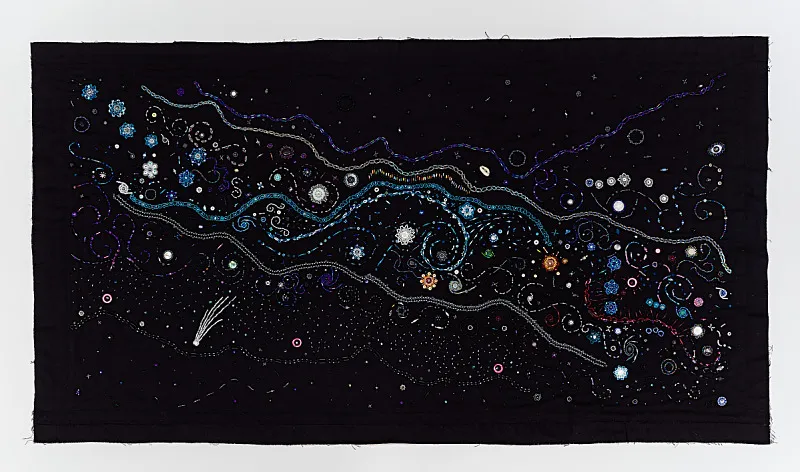Finding Our Place in Space Through the Lenses of Art, Culture, History and Science
A new Smithsonian guide features tips for exploring objects in the sky, examines technology that helps us better understand the universe, and explores ways culture and the arts have used the cosmos to stimulate our imaginations
:focal(571x223:572x224)/https://tf-cmsv2-smithsonianmag-media.s3.amazonaws.com/filer_public/21/a9/21a9168d-e8ca-45d0-862a-8c435faab62a/23-1358-si-usat-wonderawe-twitter.jpg)
Some of humanity’s greatest unresolved questions are about the nature of the universe. These questions have been pondered for generations, as people seek to understand how the galaxies, stars, and planets originated. At the Smithsonian, planetary scientists and astrophysicists continue to lead the quest to unlock the fundamental secrets of the cosmos, bringing us closer to answers than ever before. They explore Earth’s place in our own solar system, as well as other earth-like worlds orbiting around distant stars; they investigate the history of the Universe from Earth's geological past and present to the formation and evolution of planets, stars, and galaxies; and they showcase the results of their explorations and connect them to humankind's artistic and cultural endeavors.
Not an astrophysicist? No problem! Everyone, no matter their age or background can make a personal connection to the sky. To get started, think about these connections you may have to the cosmos: seeing a “shooting star,” tracing patterns in constellations, taking family trips outdoors, enjoying favorite sci-fi movies or books, witnessing historical astronomical events like an eclipse, attending sun or moon-centered festivals, or even experiencing seasonal observations.
Finding Our Place in Space
A new Smithsonian guide, “Wonder & Awe," features stories and activities that connect us to our “place in space” through the lenses of art, culture, history, and science. The sky belongs to everyone – from the women who mapped the universe over a century ago, to the astronomers who captured the first picture of a black hole, to the artists who inspire us with celestial connections.
Arts and Culture in the Universe
Artist Alma Thomas (1891–1978) was curious about the wonders of the universe. A singular figure in the story of twentieth-century American art, Thomas developed her unique style of abstract painting after retiring from a long career as an art teacher in Washington D.C. Her colorful, rhythmic paintings were influenced by elements of nature, music, and space. The Smithsonian American Art Museum holds the largest public collection of works by Alma Thomas in the world. Many of Thomas’s space paintings - - from her shimmering red canvas inspired by the supergiant star Antares, to her rainbow-hued round composition referencing the Apollo 8 lunar module nicknamed “Snoopy” - - reflect the vibrant optimism of the space age. Her painting The Eclipse was inspired by a total solar eclipse in 1970 and reflects the moment when the Moon fleetingly blocked the view of the Sun from the Earth, morphing into a dark sphere surrounded by an explosion of light and color on canvas.

The unique vision of artists and cultural storytellers has helped translate the wonders of the universe for centuries. Oral traditions of the Tlingit in Alaska and the Pacific Northwest explain the origins of some celestial bodies and inspired artist Preston Singletary to create Raven Steals the Sun, a sculpture inspired by the story of the trickster Raven who captures the Sun, Moon and Stars and releases them to bring light into our world. Artist Margaret Nazon, a member of the Gwich’in First Nation in Tsiigehtchic, Northwest Territories, Canada, created fabric and beaded artworks based on images from the Hubble Space Telescope, combining traditional beading techniques she learned as a child with contemporary scientific imagery. Her fabric artwork Night Sky depicts galaxies of stars, comets, and constellations including Ursa Major, Cassiopeia, and Orion, the Hunter, objects that help people orient themselves in relation to the stars.
Unlocking the Mysteries of the Universe
Unraveling the mysteries of the Universe is a complicated process, with each discovery building on the last. At the Smithsonian, we have a long history of peering into the cosmos in search of these answers. Samuel Pierpont Langley, the third secretary of the Smithsonian, founded the Smithsonian Astrophysical Observatory (SAO) in 1890, primarily for studies of the Sun. Today, SAO’s efforts to understand the physical processes on the Sun and the many ways it influences Earth, like all of our astrophysics research, takes teams of experts from varied backgrounds to pursue. In fact, it’s this collaborative effort that makes modern astrophysics research so successful. From engineers, to imaging scientists, astrophysicists to artificial intelligence experts, data scientists to educators, broad and diverse teams are needed to answer our unresolved questions about the nature of the universe.
As Mary Dussault, Science Education Program Manager at the Smithsonian Astrophysical Observatory puts it: “There are thousands of things you can do in science education. First, you get to learn more about the universe. Then, you can do whatever you're great at to help other people learn. If you're an artist, you can create great info-graphics; if you're a writer, you can write fascinating articles; if you're a hands-on maker, you can create museum exhibits; if you're a you-tuber, you can create videos that teach science; if you like teamwork, you can coach other educators.”
/https://tf-cmsv2-smithsonianmag-media.s3.amazonaws.com/filer_public/d5/ac/d5ac0280-2ea1-4933-a52c-ec1c858bfc9a/awardees2024.jpg)
Expanding Astronomical Horizons
NASA’s Great Observatories have given, and continue to give, us some of the most awe inspiring peeks into our universe. Their ability to capture information beyond that which our eyes can see provides us with new and exciting opportunities to understand the world around us every day. The Chandra X-ray Observatory, one of these great observatories – currently celebrating its 25th anniversary, recently joined forces with the James Webb Space Telescope to discover the most distant black hole ever detected in X-rays. This new discovery is considered the best evidence to date that some early black holes formed from massive clouds of gas. But you don’t have to have access to NASA telescopes to be a part of this great community of night sky investigators! You simply have to be curious.
Here’s some great ideas to get you started:
- Pay attention to the Moon and Sun. Everyone, no matter where they live, can join in observing our two most celebrated celestial objects.
- Start Looking Up: Find a dark place like a highschool ball field, a park, or in a city this might be a rooftop you have safe access to. Bring a blanket, and let your eyes adjust. Searching for constellations is a great way to start.
- Telescopes and binoculars can really enhance your observing experience. Did you know many libraries have telescopes you can borrow!
- Take your own images using the Smithsonian Astrophysical Observatory’s MicroObservatory Robotic Telescopes. All you need is an email address to get started.
- Explore the Universe with your other senses, and listen to A Universe of Sound, a project from the Chandra X-ray Observatory to translate data into sound.
We hope you’re inspired by the work of scientists, artists, designers, and historians featured in this guide. Tomorrow’s eclipse is a reminder that the sky belongs to everyone. Take this opportunity to expand your horizons, and examine your personal, cultural, and scientific connections to the sky. Just like the Universe, our connections to the world around us are ever evolving. What stories do you want to tell about your place in space? Join the Smithsonian in expressing them through poetry, painting, song, and more. Then share them– with your friends, your family, and with us!
Editor's Note: The "Wonder & Awe" guide is now available online for viewing and download, featuring connections to the story of the Smithsonian's sunburst logo and the graphic designer Crimilda Pontes who created it; how artists including Alma Thomas, Margaret Nazon (Gwich’in Tsiigehtchic, Northwest Territories), and Preston Singletary (Tlingit), have been inspired by celestial objects; ongoing research and data collection from the Smithsonian Astrophysical Observatory and its partners; tips for observing the night sky; and pathways for students to learn more about astronomy through programming and research opportunities.

